The Roman Empire in West Africa › Tushpa › Ancient Olympic Games » Origins and History
Articles and Definitions › Contents
- The Roman Empire in West Africa › Origins
- Tushpa › Origins
- Ancient Olympic Games › Origins
Ancient civilizations › Historical places, and their characters
The Roman Empire in West Africa › Origins
Ancient Civilizations
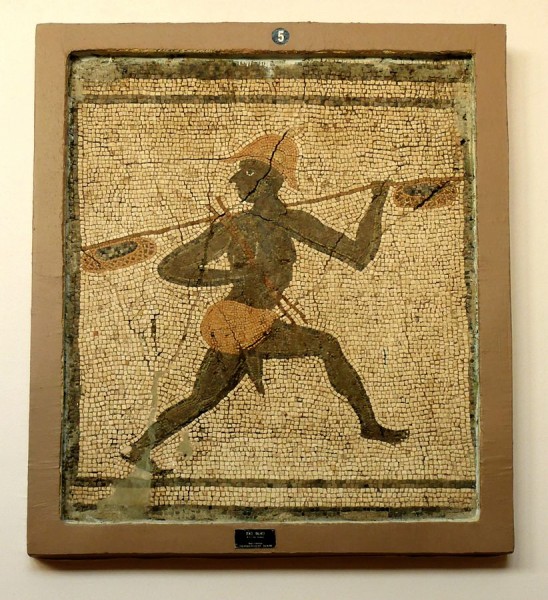
Roman Mosaic of an Aethiopian Fisherman
Classical Greek and Roman writers refer to all of Sudanic and Sub-Saharan Africa as 'Aethiopia', while the term 'Africa' originally referred only to the Maghreb region on the northwestern coast of the continent. Most Aethiopians in the Roman Empire likely came from East Africa through Egypt and Nubia but new evidence has also highlighted the role of trade and military interactions between West Africa and the Roman Empire.
ROMAN EXPLORATION IN WEST AFRICA
Roman expeditions into the Sahara were well documented beginning in the early Imperial period, though they decreased in Late Antiquity as a result of the accelerating desertification of North Africa. In 19 BCE, the Roman proconsul Cornelius Balbus led a force of 10,000 legionaries into Libya to punish the Garamantes, a Berber people who inhabited the Fezzan region of the Libyan Desert in the northeast Sahara, for rebellious activity. Balbus conquered the city of Ghadames before marching on Garama (Germa) and conquering it. After this, he penetrated the continent further south until reaching what is believed to be the Niger River.
The Roman general Suetonius Paulinus quelled a rebellion in Mauretania in 40 CE, before embarking on a celebrated expedition across the Atlas Mountains and into the Fezzan region of the Sahara (c. 41 CE). In 50 CE a general named Septimius Flaccus led a military expedition against nomadic bandits who were troubling Leptis Magna in modern-day Lybia.His expedition proved successful but what was most impressive was that his journey went far further south than the Saharan desert. In fact, Flaccus made it as far as an enormous lake surrounded by elephants and rhinoceroses (Lake Chad) before returning.
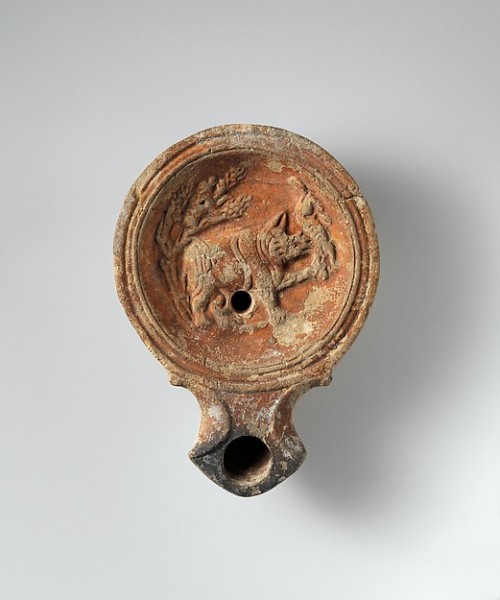
Roman Terracotta Oil Lamp with a Rhinoceros Image
According to the 2nd-century CE Alexandrian historian Ptolemy, a Roman merchant named Julius Maternus led an expedition to retread Flaccus' footsteps and open up new trade routes in West Africa. This journey is thought to have been sometime around 83 CE and plotted through what is now Libya to the city of Garama. The Garamantian king allowed Maternus to accompany him on an expedition south and sent letters of introduction to the African kings in the south on behalf of the Roman. Maternus ultimately travelled to Lake Chad before returning to Rome with a two-horned rhinoceros which was displayed in the Colosseum. This animal would have been either a black or white rhinoceros from Central Africa and was a sensation in Rome -due to its performance in the arena. The Roman Emperor Domitian (81-96 CE) was so impressed with the beast and its reception that he minted coins bearing its image sometime between 83 and 85 CE.
SOURCES OF TRADE ON THE NIGER RIVER
Ancient cities and polities in West Africa which had developed along the Middle Niger were participants in the sporadic trans-Saharan trade relations of antiquity. These settlements developed independently in West Africa and are based on a radically different economic, social, and architectural model than the urban centres of Mesopotamia, North Africa, and the Mediterranean. These cities and settlements traded goods like locally grown crops with Saharan contacts for rare foreign imports.
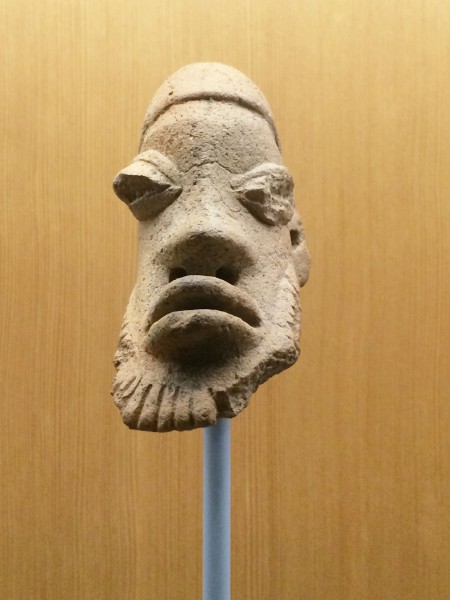
Terracotta Head from Mali's Inland Niger Delta Region
Djenne-Djenno, built near modern-day Djenne, Mali by the Iron Age Nok culture in the early 3rd century BCE, has some of the oldest known evidence of Classical Mediterranean trade in West Africa. Traders in Djenne-Djenno were importing glass beads of Roman or Hellenistic origin as early as the 3rd century BCE. Evidence of trans-Saharan trade has been found in Kissi, Burkina Faso and Dia Shoma, Mali which means that this trade did not deal exclusively with the cities of the Middle Niger but extended to the Niger Bend as well.
SAHARAN INTERMEDIARIES
The extent of trans-Saharan contact between the peoples inhabiting the Sahara desert has long been debated despite the frequent allusions of the Greek and Roman accounts, including sources like The Histories by the 5th-century BCE Greek author Herodotus and Pliny the Elder ’s 2nd-century CE Natural History.
Between the 1st and 4th centuries CE, Rome was trading closely with the Garamante Kingdom, which had become a client state of Rome. Graeco-Roman stereotypes of the Garamantes often dismissed them as unruly nomads:
On its [Libya's] borders dwell the Garamantians, a lightly clad, agile tribe of tent-dwellers subsisting mainly by the chase. (Lucian of Samosata, Dipsas the Thirst-Snake, Ch. 2, translated by Fowler, p. 27)
Archaeologists have uncovered a different picture by demonstrating that they had permanent settlements which were supported by advanced irrigation techniques. Excavations at Garama has revealed a dynamic trade centre with a population of around 10,000. Mediterranean amphorae containing olive oil and wine as well as imported pottery attest to frequent trade with the Roman Empire. Further evidence of Roman influences comes in the form of Roman-style marble, concrete, and wine presses. Most striking, however, is the presence of a large mausoleum with very clear architectural inspiration from its Roman counterparts.

Aerial View of the Ruins at Germa (Garama)
CARBUNCLES, GOLD & ANCIENT GRAINS
One of the most important items that the Garamantes had to offer both Roman and West African traders were semi-precious stones like carnelian and amazonite. These small stones (referred to as carbuncles) were highly prized by Romans and are the primary commodity referenced in literary accounts of this exchange. Carbuncles and other semi-precious stones are the most well-represented objects from the trans-Saharan trade in West Africa. These carbuncles likely acted as a regional commodity and status symbol to locals of the Niger Bend given their rarity and the difficulty involved in obtaining them.
THE GARAMANTES PROVIDED THE ROMANS WITH FOODSTUFFS, EXOTIC SUB-SAHARAN SLAVES & POSSIBLY TEXTILES, SALT, GOLD & IVORY IN EXCHANGE FOR ROMAN WINE, OLIVE OIL & POTTERY.
In addition to this, the Garamantes provided the Romans with foodstuffs, exotic Sub-Saharan slaves and possibly textiles, salt, gold and ivory in exchange for Roman wine, olive oil and pottery. Although a large amount of Sub-Saharan goods made it to the Mediterranean, Mediterranean goods did not reach the Sub-Sahara in the same volume. The reason for this was that the Garamantes and other intermediaries tended to keep the expensive Roman products for themselves rather than exchanging them with their contacts in the south. Instead they provided their West African neighbours with salt, foods, textiles. Glass beads and copper items from the Roman Mediterranean were also traded but only occasionally.
The Garamantes imported a wide range of West African crops like rice, sorghum, cotton and pearl millet, and some of these crops were cultivated at Garama. Leather and ivory from animals like hippopotami were also imported from Sub-Saharan Africa. Domesticated animals from North Africa such as camels, chickens and donkeys were first brought across the Western Sahara in the 4th century CE as a result of trans-Saharan trade.
A West African gold trade route is thought to have opened up to the Roman Empire for a brief time during Late Antiquity. Gold ore was mined in the Niger Bend before being transported upriver and ultimately reaching Roman cities in North Africa. The existence of this pre-Islamic gold trade has been reinforced by the fact that Roman gold coin mintage in Carthage and Alexandria only began in 295 CE and lasted until 429 CE when it was disrupted by the Vandal invasion of North Africa. This gold trade explains the appearance of Roman glass, carnelian and textiles in Kissi, near the Sirba goldfields on the Niger Bend during the late 3rd century CE. This trade was a precursor to the medieval gold trade which was carried out in West Africa by Islamic traders beginning in the 7th century CE.
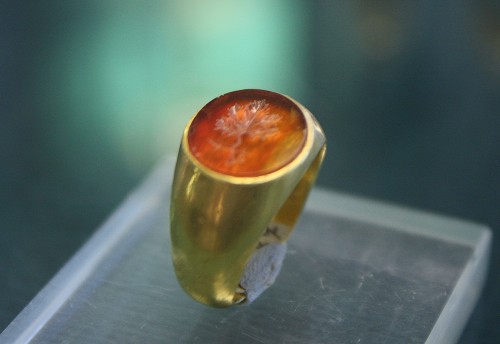
Gold & Carnelian Ring, Herakleia
Archaeological finds of Roman coins in Sub-Saharan Africa are extremely rare, but the same is true of Arabic coins despite the enormous scale of the medieval Islamic trans-Saharan trade. This is largely due to the fact that West African societies did not use a system of minted coinage as currency, so any imported coins would most likely be recirculated back north or melted down for their precious metals.
SLAVE TRADE
More than rice and gemstones were brought north of the Sahara, however, and, in many ways, the movement of people has left a more enduring impact on the archaeological record than gold. Sub-Saharan slaves fulfilled an important role as labourers in Garama, where vast amounts of manpower were needed to maintain the expansive canal systems. Garamantian raiding activity against their Sub-Saharan neighbours may well have been an important source for the trans-Saharan slave trade of antiquity, more so than voluntary exchange. The Garamantes were reported to routinely hunt their southern neighbours from horse-drawn chariots:
These Garamanteans of whom I speak hunt the "Cave-dwelling" Aethiopians [Troglodytes] with their four-horse chariots... ( Herodotus, The Histories, Book IV, Ch. 183, translated by Godley p. 387)
Saharan rock paintings which portray Garamantian chariots have been pointed to as evidence of periodic raids. The Garamantes also exported slaves to their Roman trading partners. Certain “Aethiopians” within the Roman Empire were associated with the Garamantes which implies Roman familiarity with Sub-Saharan Africans in Garamantian society. These slaves were transported as part of trade caravans which embarked from cities like Garama and travelled through the Sahara to the North African coast.

Hellenistic Bronze Statuette of an Aethiopian Youth
The Roman trade in Sub-Saharan slaves dealt primarily in children and was conducted through port cities like Alexandria and Roman Carthage before reaching Europe and the Near East. In the Imperial Period, this trade seems to have been heavily weighted towards the Roman sex industry as there were far less expensive sources of slaves for agricultural or other manual labour, such as Italy, Gaul, and the Near East.
While most West Africans in the Roman Empire likely ended up in the Mediterranean as a result of slavery, doubtless others lived within the borders of the empire as free people. “Aethiopians” are known to have served in the Roman military, were living in territories captured by the Romans, and travelled to Roman territories under their own initiative as traders or envoys.Even foreigners originally enslaved by Rome could find themselves freed and enfranchised. “Aethiopian” scholars, soldiers, athletes, and performers are known to have contributed to Roman society based on art, literature, remains and inscriptions from throughout the Roman world.
A NEW PERSPECTIVE ON TWO ANCIENT WORLDS
In the popular imagination, European and Middle Eastern contact with Sub-Saharan Africa is a relatively recent, the intermittent relationship between the Roman Mediterranean and West Africa shows how very different cultures attempted to reach far outside the horizons of their known world. Through trade networks like these, ancient civilisations were able to overcome the Sahara desert, one of the greatest natural barriers in the world, an achievement which was rewarded by material and cultural wealth for those involved.
Tushpa › Origins
Definition and Origins
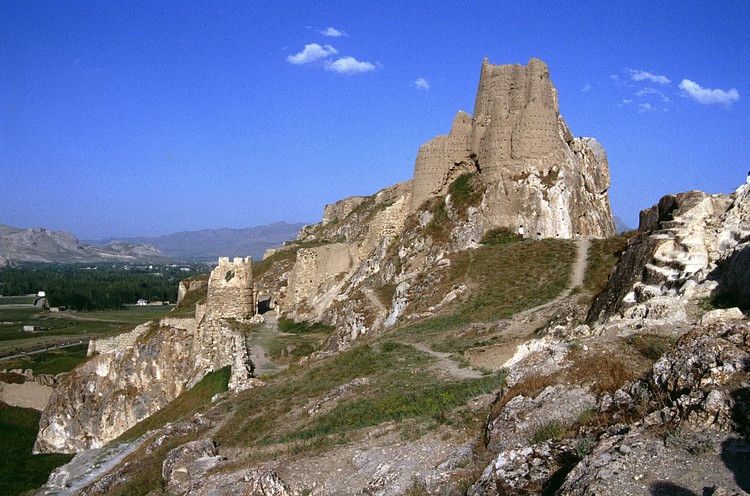
Tushpa, later known as Van, was the capital of the Urartu kingdom of ancient Armenia, eastern Turkey, and western Iran from the 9th to 6th century BCE. Located on the eastern shore of Lake Van in modern Turkey, the city was a fortress site which was reused as a provincial capital under the Achaemenian Empire and then, once again, made the capital of the Artsruni kingdom during the medieval period. Tushpa/Van is the oldest continuously inhabited city in the region.
FOUNDATION
Tushpa was founded by king Sarduri I (rc 835 - 825 BCE) around 830 BCE to function as the capital of the Urartu civilization, a loose confederation of kingdoms which covered territories in Eurasia from the Euphrates River to Lake Urmia and territory north of the Taurus Mountains. In the highlands around Lake Van, the traditional heartlands of Urartu and subsequent Armenian kingdoms, the fortress of Tushpa was built on a limestone promontory on the eastern shores of the lake. The height of the rock is in places 115 metres (375 feet). The city was named after the goddess Tushpuea (aka Tushpues or Tushpua), who was the consort of Shivini, the Urartian sun god. The name Van derives from the Urartian people's name for their region, Biaina. Tushpa/Van perhaps had a population as high as 50,000 at its peak, and it subsequently gave its name to the region: Tosp.
SIGNIFICANT CONSTRUCTION PROJECTS INCLUDE THE MASSIVE CYCLOPEAN WALLS OF FORTRESS TUSHPA.
A GARDEN CITY
Tushpa prospered thanks to the fertile plains around it, the Urartians' skills in animal husbandry, especially horse-breeding, and its location near trade routes which connected the Mediterranean with central Asia. The Urartians were also innovative and ambitious architects. Significant construction projects include the massive cyclopean walls of fortress Tushpa. With parts still standing today, the walls used huge stone blocks measuring around 6 m long and 75 cm thick. One portion of wall, perhaps originally intended as a pier or breakwater, carries an inscription in Assyrian. Carved during the reign of Sarduri I, it states:
An inscription of Sarduri, son of Lutipri, the magnificent king, the mighty king, king of the universe, king of the land of Nairi, a king having none equal to him, a shepherd to be wondered at, fearing no battle, a king who humbled those who would not submit to his authority. I, Sarduri, son of Lutipri, king of kings, received tribute from all the kings. Sarduri, son of Lutipri, says: “I procured this limestone from the city of Alniunu, I erected this wall”.(Piotrovsky, 49)
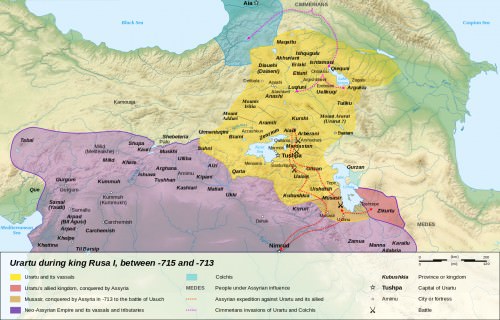
Urartu 714-715 BCE
Another great engineering achievement was the 80-kilometre long stone-lined canal which brought fresh water from the Artos mountains to the capital (Lake Van is a saltwater lake). The structure was built by king Menua (rc 810-785 BCE) and allowed the proliferation of vineyards and orchards, resulting in Tushpa gaining a reputation as a garden city. The aqueduct was raised where necessary on large stone blocks and these often carry inscriptions which name the builder and warn of a curse on any person who destroys the structure or claims it as their own work as in this example:
Whosoever damages this inscription, whosoever overturns it, whosoever does such things according to his desire or in the name of another, Menua warns that the dread god Khaldi, the god Teisheba and the sun god Shivini will efface him from the sight of the sun. (Chahin, 74)
The canal continues to function and is still used today by farmers in the region to irrigate their fields.
During Menua's reign, the city also spread around the citadel and along the shores of Lake Van, which are fertile and sheltered from the harsher extremes of the region's climate. In the reign of Argishti II (rc 714-680 BCE), a new settlement was developed on the nearby hill of Toprakkale. The site, which became the royal palace, was completed by Argishti's son and successor Rusa II (c. 680-638 BCE) when it was renamed Rusahinili.
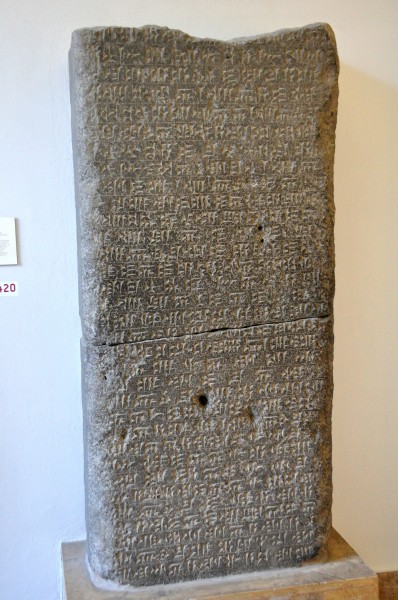
Stele of the Urartian King Rusa II
The capital had a royal necropolis composed of chambers cut into the mountain on which the city was built. Tombs are composed of single, double, or triple chambers with the tomb entrance sealed by a large stone slab. Several royal tombs, long since looted, still carry inscriptions describing the achievements of their occupant. Of those tombs discovered intact, several contain stone sarcophagi with semicircular lids. Buried with the deceased were precious goods, weapons, shields, and even furniture, a practice which suggests the Urartians believed in an afterlife and that it was similar enough to the earthly one to necessitate such provisions.
MANY CUNEIFORM INSCRIPTIONS MADE INTO THE ROCK DESCRIBE THE KINGS OF URARTU & SOME OF THEIR GREAT DEEDS.
Other surviving remains from this period include an open-air shrine with smooth walls carved out of the rock, finds of figurines such as winged goddesses who might have once adorned bronze cauldrons, fragmentary stone statuary of deities, and many cuneiform inscriptions made into the rock face which describe the kings of Urartu and some of their great deeds.
ASSYRIAN WARS
There were trade relations between Tushpa and the mighty Neo-Assyrian Empire but also major conflicts, too. Urartu did enjoy some victories in the mid-8th century BCE, but the Assyrian ruler Tiglath-Pileser III (r. 745-727 BCE) was more aggressive than his predecessors, and he laid siege to Tushpa in 736 BCE. The attack is recounted in the Assyrian annals of Tiglath-Pileser:
I shut up Sarduri [II] the Urartian in Turushpa [Tushpa], his principal city, and wrought great slaughter in front of the city gates. Then I set up the image of my majesty over against the city. (Piotrovsky, 83)
Fortunately for the Urartians, the city's walls did their job and the fortress remained impregnable. The Assyrians, nevertheless, torched and plundered the lower city, along with many others in the kingdom.
Another significant conflict between the two states was during the campaign of Sargon II (722-705 BCE) in 714 BCE, although Tushpa was not directly attacked. In the 7th century BCE, the Urartu kingdom came to a mysterious but violent end when sometime between c. 640 and c. 590 BCE their cities, including Tushpa, were destroyed. The state was probably weakened by decades of battles with the Assyrians, and it may have been too overstretched to control its own empire. The perpetrators are not known, but the Scythians are one candidate, the Cimmerians another, and even possibly forces from within the territories administered by the Urartu kings.
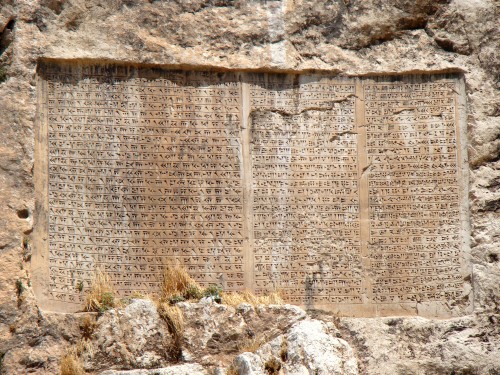
Xerxes' Inscription, Van
ACHAEMENID RULE
The territories the Urartu kingdom had once occupied were ultimately taken over by the Medes from c. 585 BCE onwards and Van was rebuilt. The region was shortly afterwards incorporated into the Achaemenian Empire of Cyrus the Great in the mid-6th century BCE. Van then became the seat of the Persian satrap who governed the new province. From this period comes the now-famous lengthy inscription on the rock face of Van. Made during the reign of Xerxes (486-465 BCE) it is written in the three official languages of the Achaemenian Empire - Old Persian, Elamite and Babylonian - and describes the king's divine right to rule over his empire:
A great god is Ormuzd, who is the greatest of gods, who created this earth, who has created that heaven, who has created mankind, who has given happiness to man, who has made Xerxes king, sole king of many kings, sole lord of many. I am Xerxes, the great king, the king of kings, the king of the provinces with many tongues, the king of this great earth far and near, son of king Darius the Achaemenian. Says Xerxes the King: Darius the king, my father, did many works, through the protection of Ormuzd, and on this hill he commanded me to make his tablet and an image; yet an inscription he did not make. Afterwards I ordered this inscription to be written. May Ormuzd, along with all the gods, protect me and my kingdom and my works. (Chahin, 69-70)
HELLENISTIC PERIOD & SASANID RULE
During the reign of the Orontid dynasty (6th-3rd century BCE), after the fall of the Persian Empire, Van was passed aside when Armavir (the former Urartian city of Argishtihinili) was made the capital c. 330 BCE. The city remained important and benefitted from the building projects of Tigranes the Great (rc 95 - c. 56 BCE) in the early part of the 1st century BCE, although he founded a new capital, Tigranocerta, in 83 BCE which was further to the west and in a more central position within the newly expanded Armenian Kingdom.
When the Arsacid dynasty ruled Armenia (12-428 CE) Artaxata was the capital but Van remained important in the region. The city's continued importance as a trading centre resulted in it acquiring a more cosmopolitan population; the Jewish community was especially large. When the Sasanid king Shapur II (r. 308-379 CE) invaded Armenia in 368-9 CE, Van was one of the cities attacked and its whole population was forcibly relocated to Persia.
LATER HISTORY
Van did rise again to prominence during the medieval period when it was made the capital of the Artsruni (Ardsruni) kingdom which sprang up in Armenia from the late 8th century CE. The Artsruni prince Gagik, ruling under the auspices of the Abbasid Caliphate, made Van his capital in 908 CE. Yet again, the city was replaced as the royal residence, this time by Aghtamar, located on an island on Lake Van, but Van remained a thriving cultural centre if not a political one. Successively ruled by the Byzantines and Seljuk Turks, Van was sacked and destroyed in 1387 CE by Timur Leng, the Turco-Mongol conqueror (r. 1370-1405 CE) who then hurled 7,000 captives over the citadel's walls to their deaths. The city drifts into obscurity from then until the Ottoman period and a return to regional importance in the 19th century CE when it became a centre for Armenian rebellion against Turkish rule.
This article was made possible with generous support from the National Association for Armenian Studies and Researchand the Knights of Vartan Fund for Armenian Studies.
Ancient Olympic Games › Origins
Definition and Origins
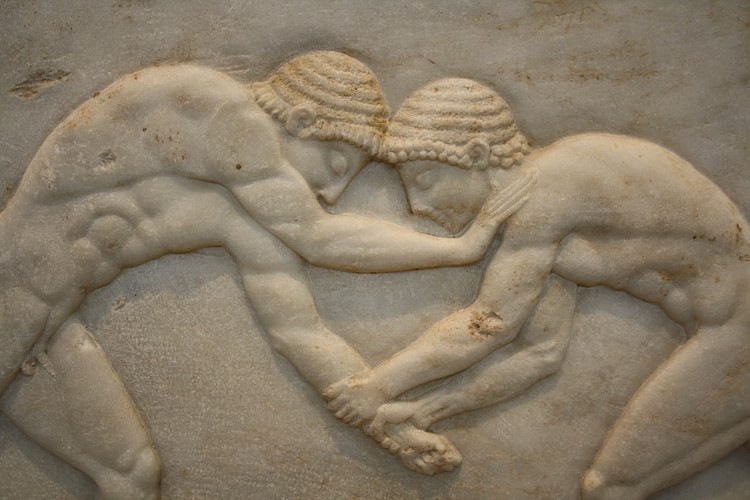
The ancient Olympic Games were a sporting event held every four years at the sacred site of Olympia, in the western Peloponnese, in honour of Zeus, the supreme god of Greek religion. Involving participants and spectators from all over Greece and even beyond, the Games were the most important cultural event in ancient Greece and were held from 776 BCE to 393 CE, a run of 293 consecutive Olympiads. So important were the Games in the ancient world that they were even used as a basis for the calendar.
ORIGINS OF THE GAMES
Sporting events were originally associated with funeral rituals, particularly those of heroes and the fallen in battle, for example, the games for Patroklos in Homer ’s Iliad. At Olympia, in particular, some mythological accounts credit Zeus with beginning the Games to celebrate his victory over Kronos whilst other accounts state the hero Pelops began them in honour of Oinomaos. In any case, sport, a healthy body and the competitive spirit were a large part of Greek education and so it is hardly surprising that organised athletic competitions would at some point be created, as they had been in the earlier Minoanand Mycenaean civilizations.
SPORT, A HEALTHY BODY & THE COMPETITIVE SPIRIT WERE A LARGE PART OF GREEK EDUCATION.
The first Olympics were held from 776 BCE at the first full moon after the summer solstice (around the middle of July) in honour of Zeus. The winner of the first and only event, the stadion foot-race was Koroibos of Elis and from then on every victor was recorded and each Olympiad named after them, thus giving us the first accurate chronology of the ancient Greek world.An Olympiad was not only the name of the event itself but also of the period between games. During a three-month pan - Hellenic truce, athletes and as many as 40,000 spectators came from all over Greece to participate in the Games at Olympia.Later, other games would be organised at other sacred sites such as Delphi, Isthmia and Nemea but the Olympian Games would remain the most prestigious.
The Games started with a procession which went from the host town of Elis to Olympia, led by the Hellanodikai (judges) and on arrival at Olympia all athletes and officials swore an oath to follow the established rules of the competitions and to compete with honour and respect. The most important religious ceremony of the event was the sacrifice of 100 oxen, known as the hecatomb, at the altar of Zeus, carried out when the sporting events were over.
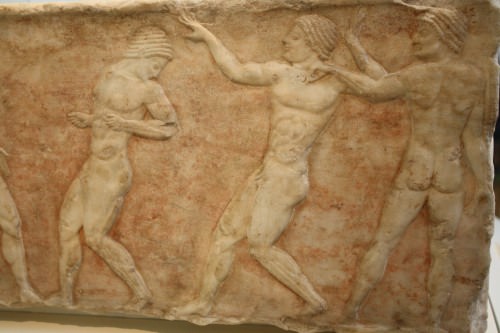
Greek Athletes
THE SPECTATORS
Heralds ( spondophoroi ) were sent from Elis to advertise the coming of the Games across Greece. Spectators came from not only the Greek mainland but also the islands, Ionia and Magna Graecia. To facilitate the movement of spectators and athletes and in respect of the religious importance of the Games a sacred truce ( ekecheiria ) was called across Greece.Initially, the truce was for one month but in later centuries it was extended to three. No wars were permitted, no arms could be carried in the territory of Elis and no hindrance was to be given to any spectator, athlete or theoriai - (the official missions representing particular cities ) travelling to the games from wherever they came from and whichever territory they had to cross.
The site of Olympia must have been positively buzzing during a Games with mass crowds of excited spectators staying in make-shift camp sites (only later was accommodation provided for the visitors) and admiring the masses of fine statues and buildings at the site. Food vendors, craftsmen, musicians, poets and philosophers took full advantage of the crowds to publicise their wares or ideas. Just how many spectators attended each Games is unknown but we do know that around 45,000 spectators consisting of men, slaves and foreigners sat and watched from the embankments of the stadium which hosted the main events. Spectators actively participated in the events through their boisterous support of the athletes and after each event they showered flowers and laurel leaves on the victors.
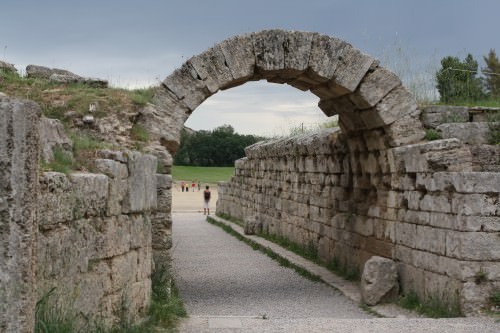
Stadium Entrance, Olympia
Women were not permitted to participate in or watch the events although young girls were allowed in the crowd. There was a single exception to this rule, the priestess of Demeter Chamyne. A famous breach of the men only rule was the case of Kallipateira. She had trained her son Peisirodos and when he won his race his mother, celebrating a little too exuberantly in the crowd, loosened her clothes and revealed her sex. She escaped the prescribed punishment of the death penalty because she came from a family of great Olympic victors but from then on all trainers had to be naked - like the athletes - to avoid such an occurrence in the future.
THE ATHLETES
WHO OF MEN TODAY HAS BEEN ADORNED WITH SO MANY PETALS AND MYRTLES AND CROWNS OF ROSE THANKS TO HIS VICTORY IN THE GAMES? SIMONIDES' ODE TO ASTYLOS
Athletes trained under the watchful eye of a professional trainer ( gymnastes ) or physical trainer ( paidotribes ) who knew how to best develop particular muscles, the best diet and the correct amount of exercises to be done. Trainers were often thanked by their more successful athletes by the dedication of a statue of them at the site. Athletes also had an aleiptes who rubbed them down with oil and massaged them both before exercising and after.
The athletes competed naked, probably for complete freedom of movement. Events were open to all free Greek males and the list of victors illustrates just how pan-Hellenic the Games were with athletes coming from all parts of Greece and in Romantimes the no-foreigner rule for athletes was relaxed. Victors were those who beat all other competitors. There are practically no records of times and distances achieved by victorious athletes as these were simply not considered important, the idea was to be first amongst the best, not to beat records.
THE STADION FOOTRACE
For the first 12 Olympics the stadion foot-race was the only event and it remained the most prestigious event throughout the history of the Games. The race was ran over one length (a stadion ) of the stadium track, 600 ancient feet or 192 m and preliminary heats were held with heat winners going into the final. Athletes were grouped by lot and in the interest of fairness this was also the way pairings were matched in the other events. The eventual winner of the stadion would even give his name to that particular Games and so be remembered for all time.
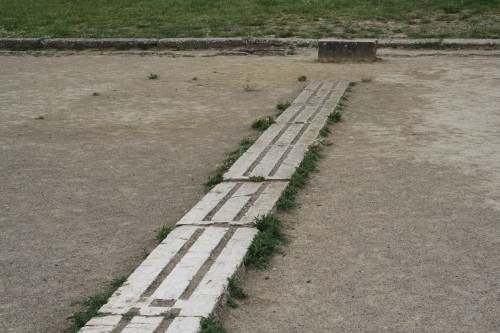
Starting Blocks, Olympia
OTHER SPORTING EVENTS
Over time other events were added to the Games to bring the total programme to 18 events spread over five days:
- diaulos - the two stadium lengths foot-race, added in 724 BCE.
- dolichos - longer foot-races 7 to 20 stadium lengths, added in 720 BCE.
- wrestling - added in 708 BCE. Competitors had to throw their opponent to the ground three times to gain victory.
- pentathlon - also added in 708 BCE. All done in a single day, the event order was: jumping (in a soft soil pit using hand-weights or halteres and accompanied to music), discuss (in stone, iron or bronze), stadion, javelin (in wood and thrown using a leather thong), and wrestling. Just how an athlete won the overall event is unclear, three event victories may have guaranteed overall victory.
- boxing - added in 688 BCE. Athletes wore straps of leather ( himantes ) around their hands, initially as protection but they evolved into destructive weapons with metal pieces added. Rules were limited to no low-blows and no holding. Serious injuries were common and deaths not unknown.
- tethrippon - the four-horse chariot race added in 680 BCE, run over ten or twelve circuits of the hippodrome. A version using foals over 8 circuits was added in 384 BCE.
- keles - a horse race added in 648 BCE and run over 6 cicuits. A version for foals was added in 256 BCE.
- pankration - a mix of boxing and wrestling also added in 648 BCE. The pankration was a brutal event and the only moves not allowed were biting and gouging, although competitors did not wear the damaging leather thongs of the boxers.
- hoplitodromos - the race in hoplite armour (helmet, shield and spear) between 2 and 4 stadium lengths was added in 520 BCE and was usually the last event of the Games.
- apene - a race with chariots pulled by two mules, added in 500 BCE (dropped from 444 BCE).
- kalpe - a trotting horse race for mares, added in 496 BCE (dropped from 444 BCE).
- synoris - the two-horse chariot race run over eight circuits of the hippodrome, added in 408 BCE. A version using foals over three circuits was added in 268 BCE.
- competitions for trumpeters and heralds - added in 396 BCE. This was held on the first day and the winners - those whose sound carried the furthest - were also given the honour of announcing the victors on the final day at the official prize-giving event.
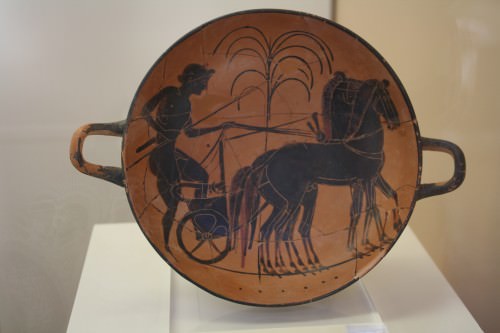 GREEK CHARIOT
GREEK CHARIOT

COMPETITION RULES & JUDGES
Athletes had to arrive at Olympia one month before the Games for training and, further, they had to declare that they had been in training for at least ten months. Non-Greeks, slaves, murderers, those convicted of defiling temples and all those who had not respected the truce were excluded from participating. Indeed, cities could be included in the latter category, for example, Sparta in 420 BCE.
THE HELLANODIKAI JUDGES HAD THE POWER TO DISQUALIFY & FINE ATHLETES FOR ANY INFRINGEMENT OF THE RULES.
The events were supervised by trained judges from Elis, the Hellanodikai (or agonothetai ) who also had various assistants such as the alytai (police officers). For the first 49 Olympics there was only one judge but he was joined by others to reach a peak of twelve, distributed amongst the various events. Originally, the office was hereditary and for life but later judges were selected from Elis by lot. The Hellanodikai had the power to disqualify and fine athletes for any infringement of the rules and, wearing their purple cloaks, they were given special seats of honour in the stadium. The decisions of the Hellanodikai could never be revoked but the judges were themselves subject to judgment from a council of elders and should an athlete successfully appeal, the judge concerned could be fined.
Rules were very rarely broken and when they were penalties were imposed ranging from exclusion and fines to flogging. Fines were paid both to the sanctuary and the wronged athlete. If an offender did not pay the fine then the city he represented had to or else be excluded from the next Games. Revenue from fines was in part used to erect statues of Zeus known as zanesand a number of the bases of these statues can still be seen at the site today.
OLYMPIC PRIZES
The Hellanodikai also gave out the victory crown ( kotinos ) of wild olive leaves and an olive branch cut from the scared tree ( Kallistephanos ) to each event winner. The olive was significant because the trees of Olympia were believed to have been originally planted by Hercules. Another prize could be a red woollen ribbon which was worn on the upper arm or around the head, especially for chariot racers as it was the horse owner who actually received the olive crown.
Victors were welcomed back to their hometowns as heroes after the Games. Typically entering the city in a procession where they rode a four-horse chariot, the victors had huge banquets held in their honour and they could receive additional benefits such as exemption from tax and invitations to join the political elite. Cities also received prestige from victories at the Games and for this reason they sometimes offered financial incentives for athletes such as Solon ’s 500 drachmas prize (a substantial sum considering one sheep cost one drachma at the time).
However, the real prize for athletes was glory, fame and, in a very real sense, historical immortality. This was achieved through renown whilst still alive but was perpetuated after death via victor's lists, personal statues and victory odes written in the victor's honour.
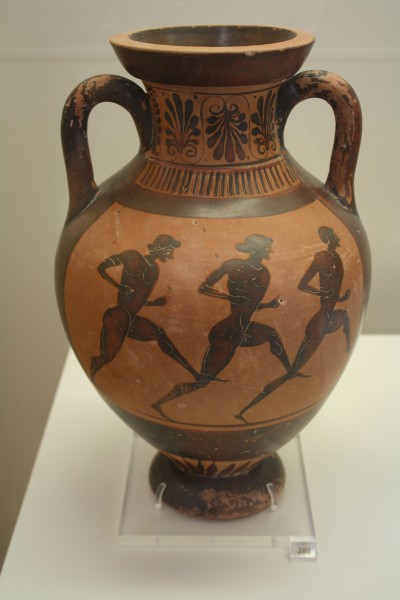
Greek Foot Race
FAMOUS OLYMPIANS
There were many great athletes who won fame and glory in multiple Games. Kroton from southern Italy won three consecutive stadion races from 488 to 480 BCE. Phanas of Pellene managed to win three events in the Olympics of 521 BCE - the stadion, diaulos and the race in armour. Leonidas of Rhodes went even better and managed to win all three events in four consecutive Olympics between 164 and 152 BCE. A feat almost matched by Hermogenes of Xanthos, known as 'the horse' who won eight running events over three Olympics between 81 and 89 CE. Milon of Kroton won the wrestling competition five times from 532 to 516 BCE and the runner Astylos of Kroton won six crowns across the three Olympics of 488, 484 and 480 BCE. Finally, Herodoros of Megara won an incredible ten consecutive trumpet competitions from 328 to 292 BCE.
The Games and their prestige also attracted famous competitors from outside the sporting world. The great Athenian general and statesman Alcibiades won three chariot races in 416 BCE. Philip II of Macedon won the horse race in 356 BCE and repeated his winning streak in the chariot races of the 352 and 348 BCE Games. Also, Roman emperor Nero famously won every event he entered in 65 CE. These powerful political leaders even sought to milk the prestige of their successes at Olympia by minting coins to commemorate their victories.
The first woman to win the crown of victory was Kyniska in 392 BCE. Although women were not permitted to compete, they could own horses and it was the owner who won the olive crown prize. Many other women went on to emulate Kyniska and Spartan women, in particular, enjoyed a high reputation in the equestrian events at Olympia.
END OF THE GAMES
The Games continued through the Hellenistic period with more buildings added to the site, greater comforts offered for the spectators and an increase in the professionalism and event specialisation of the athletes. In Roman times, although there were some changes to tradition such as Sulla ’s moving of the 80 BCE Games to Rome, the Games continued to be popular and their prestige increased under hellenophile emperors such as Hadrian. However, it was Emperor Theodosios who finally decreed that all cult practices, including Games, be stopped and the final Olympics was held in 393 CE after a run of 293 Olympics over more than a millennium.
LICENSE
Article based on information obtained from these sources:with permission from the Website Ancient History Encyclopedia
Content is available under License Creative Commons: Attribution-NonCommercial-ShareAlike 3.0 Unported. CC-BY-NC-SA License